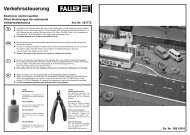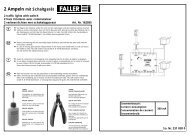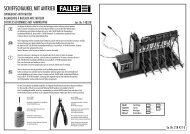INSTRUCTION MANUAL
INSTRUCTION MANUAL
INSTRUCTION MANUAL
Create successful ePaper yourself
Turn your PDF publications into a flip-book with our unique Google optimized e-Paper software.
Decoder MX620 - MX622, MX630 - MX632 Sound Decoder MX640 - MX648 Page 19<br />
3.7 Acceleration and Deceleration:<br />
CV Designation Range Default Description<br />
The basic acceleration and deceleration times (momentum) are set with<br />
CV’s #3 and #4<br />
according to the relevant NMRA standard, which demands a linear progression (the time between<br />
speed step changes remains constant over the whole speed range).<br />
For simple smooth drivability use values 3 or higher but for really slow starts and stops start with a<br />
value of 5. Values over 30 are usually impractical!<br />
The sound project in sound decoders always comes with different values in CV’s #3 and #4 (as well as<br />
many other CV’s) than what is listed in the CV charts. Often the sound can only be played back correctly<br />
in conjunction with the acceleration times provided by the sound project (or certain minimum values),<br />
so the sound project’s default values should therefore not be changed too much.<br />
Acceleration and deceleration behavior, especially starting and stopping, can be further improved by<br />
the “exponential” and “adaptive” acceleration/deceleration features (CV’s #121, 122 and 123).<br />
To eliminate a start-up jolt after changing the direction, caused by gear backlash in gearboxes, use<br />
CV #146:<br />
Some free play between gears of a drivetrain is essential to prevent them from binding. This creates<br />
backlash and may be more severe on some engines than on others, especially when fitted with a<br />
worm gear or an excessively worn gearbox.<br />
Excessive backlash leads to a peculiar behavior especially after changing the direction: When the<br />
motor starts turning in the opposite direction it doesn’t move the engine right away because it has to<br />
eliminate the backlash first. And to make matters worse, the motor starts to accelerate already during<br />
this phase. When the engine finally starts moving, the motor’s speed has exceeded the normal<br />
start-up rpm, which results in an unpleasant jolt. This can be avoided with the help of CV #146.<br />
CV Designation Range Default Description<br />
#3 Acceleration rate 0 - 255 (2)<br />
#4 Deceleration rate 0 - 255 (1)<br />
#23 Accelerationtrimming 0 - 255 0<br />
#24 Deceleration trimming 0 - 255 0<br />
The value multiplied by 0.9 equals’ acceleration time in<br />
seconds from stop to full speed.<br />
The effective default value for sound decoders is usually<br />
not the value given here, but is determined by the<br />
loaded sound project.<br />
The value multiplied by 0.9 equals’ deceleration time in<br />
seconds from full speed to a complete stop.<br />
The effective default value for sound decoders is usually<br />
not the value given here, but is determined by the<br />
loaded sound project.<br />
To temporarily adapt the acceleration rate to a new load<br />
or when used in a consist.<br />
Bit 0 - 6: entered value increases or decreases<br />
acceleration time in CV #3.<br />
Bit 7 = 0: adds above value to CV #3.<br />
= 1: subtracts above value from CV #3.<br />
To temporarily adapt the acceleration rate to a new load<br />
or when used in a consist.<br />
Bit 0 - 6: entered value increases or decreases<br />
#121<br />
#122<br />
#123<br />
#146<br />
Exponential<br />
acceleration<br />
Exponential<br />
deceleration<br />
Adaptive<br />
acceleration and<br />
deceleration<br />
Compensation for gear<br />
backlash<br />
during direction changes<br />
in order to<br />
reduce start-up jolt.<br />
0 - 99<br />
0<br />
0 - 99 0<br />
0 - 99 0<br />
0 - 255 0<br />
acceleration time in CV #3.<br />
Bit 7 = 0: adds above value to CV #3.<br />
= 1: subtracts above value from CV #3.<br />
Acceleration time (momentum) can be stretched in the<br />
lower speed range:<br />
Tens digit: Percentage of speed range to be<br />
included (0 to 90%).<br />
Ones digit: Exponential curve (0 to 9).<br />
EXAMPLE:<br />
CV #121 = 11, 23 or 25 are typical initial test values.<br />
Deceleration time (momentum) can be stretched in the<br />
lower speed range:<br />
Tens digit: Percentage of speed range to be<br />
included (0 to 90%).<br />
Ones digit: Exponential curve (0 to 9).<br />
EXAMPLE:<br />
CV #122 = 11, 23 or 25 are typical initial test values.<br />
Raising or lowering the speed to the next internal step<br />
occurs only if the preceding step is nearly reached. The<br />
tolerance for reaching the preceding step can be defined<br />
by this CV (the smaller this value the smoother<br />
the acceleration/deceleration).<br />
Value 0 = no adaptive accel. or decel.<br />
Tens digit: 0 - 9 for acceleration<br />
Ones digit: 0 - 9 for deceleration<br />
EXAMPLE:<br />
CV #123 = 11: strongest effect; sometimes affects<br />
the start up too much.<br />
CV #123 = 22: typical setting.<br />
= 0: no effect<br />
= 1 to 255: the motor spins at minimum rpm (according<br />
to CV #2) for a specific time and only starts to accelerate<br />
after this time has elapsed. This CV will only be executed<br />
after a direction change.<br />
How much time is required to overcome the backlash<br />
depends on various circumstances and can only be determined<br />
by trial and error.<br />
Typical values are:<br />
= 100: the motor turns about 1 revolution or a<br />
maximum of 1 second at the minimum speed.<br />
= 50: about ½ a turn or max. ½ second.<br />
= 200: about 2 turns or max. 2 seconds.<br />
Important: The minimum speed must be set correctly,<br />
so that the motor actually turns at the speed step defined<br />
as the lowest step in CV #2. Also, CV #146 is only<br />
useful if the load regulation is set to maximum or at<br />
least close to it (i.e. CV #58 = 200 – 255).










